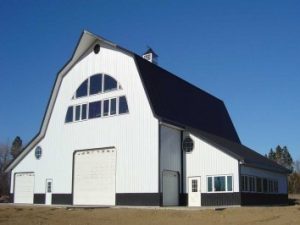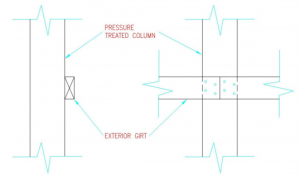Both of my post frame buildings outside of Spokane, WA have no windows on the garage/shop level. This means when inside, with doors closed, it is dark – one is forced to rely upon electricity or radar to navigate.
Reader KRISTI is preparing to build her new pole barn and had some questions about how to light up her life:
“Hi there!
I plan to have a 36’x40’ pole barn built before the cold weather hits here in Michigan and I have a couple of quick questions if you don’t mind.
First, I will be using this building as workshop so it will definitely be insulated and heated. I’m planning to run a radiant slab heat system. My first question is regarding windows. I want to be able to see outside but more importantly, I want all the daylight I can get! That in mind, which wall would you recommend to bring in the most light? How do I frame up the interior walls around the windows? How difficult is it to add windows once the insulation and sheathing is done inside? Lastly, would you recommend using clear acrylic panels along the tops of the walls? I’m a little worried it will yellow over time & I’m not sure how I could insulate the acrylic if it’s even possible.
The barn will be in an open area with little to no shade & will have a large garage door on the east end, and 12’ walls with a ceiling.
Thank you in advance for any time you should spend on answering my questions! I totally understand if you are too busy to indulge me and if I could only ask one question I would ask how to frame out the interior walls for a window.
Thanks again!”
Mike the Pole Barn Guru responds:
 To get the most light, place windows on the south wall. Easiest way to frame your exterior walls (interior walls around windows) is to use what we refer to as commercial girts (https://www.hansenpolebuildings.com/2011/09/commercial-girts-what-are-they/). Once you have finished insulating and an interior wall covering, there will be an extreme degree of difficulty to add more windows – it is best to plan for them in advance and install at time of initial construction. This also allows for them to be incorporated into engineered building plans as increasing openings. Without engineering, can compromise the structural integrity of your building. While eave light panels are very effective for unheated buildings, in your case you would be heating much of Michigan, if you used them. Here is some more reading on light panels: https://www.hansenpolebuildings.com/2014/02/acrylic/.
To get the most light, place windows on the south wall. Easiest way to frame your exterior walls (interior walls around windows) is to use what we refer to as commercial girts (https://www.hansenpolebuildings.com/2011/09/commercial-girts-what-are-they/). Once you have finished insulating and an interior wall covering, there will be an extreme degree of difficulty to add more windows – it is best to plan for them in advance and install at time of initial construction. This also allows for them to be incorporated into engineered building plans as increasing openings. Without engineering, can compromise the structural integrity of your building. While eave light panels are very effective for unheated buildings, in your case you would be heating much of Michigan, if you used them. Here is some more reading on light panels: https://www.hansenpolebuildings.com/2014/02/acrylic/.
We will be looking forward to helping you with your new pole barn!








I’m also constructing a pole barn 32 x 76 with no windows like you have. I’m looking for your advice in spacing the light fixtures for a 12 ft ceiling. I purchased 4ft fluorescent (2 bulb) lights and would appreciate your recommendation on spacing. FYI, I really appreciate your posts and have incoprporated several of your recommendations into my design such as commercial girts and vapor barrier placement. Also, your sheet metal screws rock! They are way higher quality than anything that I have seen previously.
Thank you for your kind words – personally I think the screws we are using are literally “all that and a bag of cheetos”. I like lots of light so my recommendations might not be the best for your situation. My best recommendation is to begin with trial and error. Spread them out rather sparsely across a small portion of your building (say four or six in a 32′ x 24′ area) and see how the lighting is – too dark, add more.